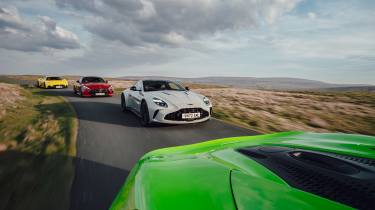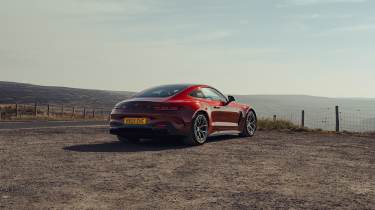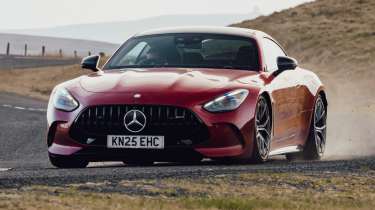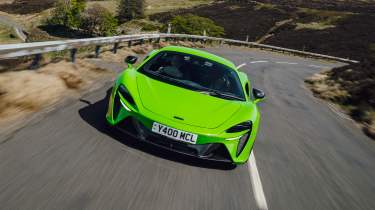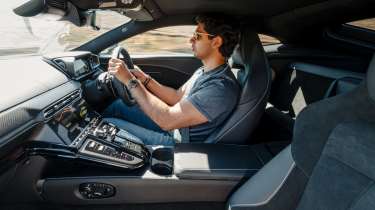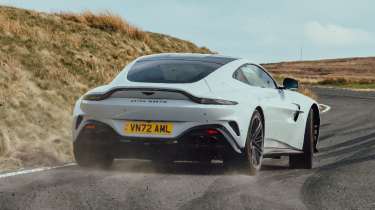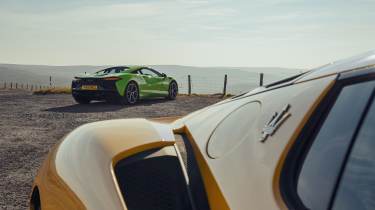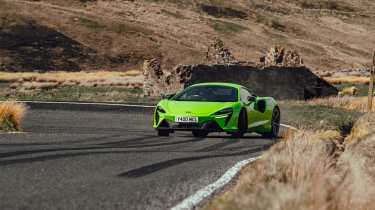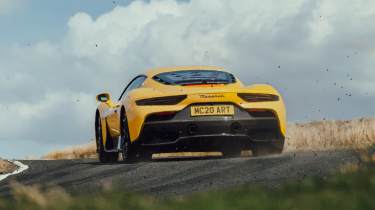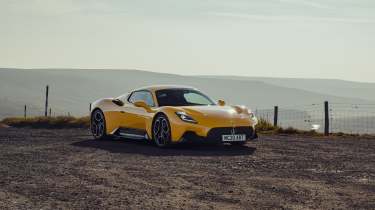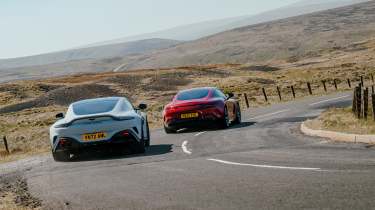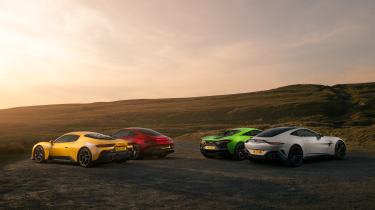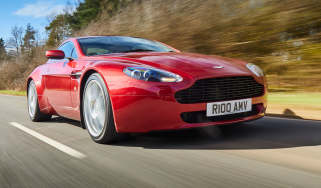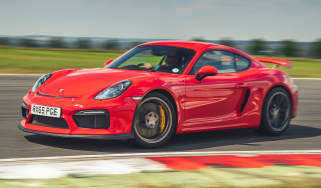£200,000 supercar shoot-out: AMG v Aston Martin v Maserati v McLaren
Aston Martin Vantage v Maserati MC20 v McLaren Artura v Mercedes AMG GT 63 S E Performance: Four different ways to spend circa £200k, but which is the best performance car?
What do we have here, then? A pair of twin tests or a four-car group test? Perhaps confusingly it’s both. It used to be that 600bhp-plus and 200mph was the exclusive preserve of God-tier exotics. But thanks to relentless engineering advances, the advent of hybrid powertrains and the top-heavy nature of the high-performance luxury car market, all that has changed. So, in a change from the more predictable apples-to-apples comparison test, we’ve picked an eclectic quartet of stellar GT, supercars and sports cars. One that defies conventional comparisons but – we think – is more intriguing for it. Which one is your money on?
In the broadest sense, all four can be described as mid-engined, the Aston and AMG tucking their biturbo V8 petrol engines just behind their front axles, Maserati and McLaren mounting their twin-turbo V6s just behind the cockpit. Adding further spice to the mix, both the Aston Martin Vantage and Maserati MC20 stick to old-school pure ICE powertrains while the Mercedes-AMG GT63 S E Performance and McLaren’s Artura elect to augment internal combustion with battery-electric hybrid systems
Proper cars need a proper trip, so our plan is to head north. A long way north, to Hexham and the wide open wilderness of Northumbria and Cumbria. Fellow editor-at-large John Barker is completing the preliminary drive in the Aston, with senior staff writer Yousuf Ashraf bringing the MC20. That leaves rent-a-driver (and old friend of evo) Tim Smith to join us in the McLaren, while I’m heading up in the big AMG.
I spent a bit of time in the GT63 S earlier in the year, but that was mostly on track, so this is the first time I’ve spent meaningful road miles in AMG’s new-generation sports GT. The £186,290 (£190,390 as tested) E Performance is a big step on, both in terms of power and torque, but also weight. Indeed, the big Benz is a graphic demonstration of the pros and cons of high-performance hybrids, and why the notion of them often leaves us so conflicted. No two ways about it, the AMG is both a beast and obese; its eye-widening combined outputs of 805bhp (604bhp from the V8 and 201bhp from the electric motor) and 1047lb ft shackled to an equally shocking kerb weight of 2120kg.
More reviews
Group tests
- Aston Martin Vantage V600 v Aston Martin Vantage GT8 – limited-run Astons go head-to-head
- Aston Martin Vantage vs Audi R8 V10 RWD – back to basics
In-depth reviews
- Aston Martin Vantage 2025 review – a thrilling alternative to the McLaren Artura
- Aston Martin Vantage (2018 - 2024) review – British, brutal and brilliant fun
Reviews
> Maserati MCPura launched as MC20 replacement – McLaren rival makes public debut
Looks-wise it exudes the kind of presence you’d expect and want from such a potent machine, though once you’ve clocked its increasing resemblance to a Porsche 911 (especially the side profile) it’s hard to unsee it. If the original AMG GT was a freshly unwrapped boiled sweet, this latest model is the same sweet sucked smooth.
As you can imagine, there’s a bewildering degree of configurability across pretty much every area of the car. Helpfully you can access the dynamic modes via the touchscreen or the rotary switches on the steering wheel, but there’s no denying it’s a fiddly business that will take many hours of use to become remotely intuitive.
Being hybrid, the E Performance starts silently, relying on you to switch it away from its default start-up mode and awaken the petrol engine in time-honoured AMG style. While I’d be lying if I said it doesn’t tickle me to feel and hear the seismic thud of that familiar 4-litre biturbo V8 as it bursts into life, I also enjoy the novelty and understatement of rolling on battery power alone.
First impressions are of a big and immensely muscular machine. One that will take a bit of time to truly connect with but is immediately likeable. As with all AMGs, the interior is quite busy and showy, but you soon settle in and learn to enjoy its big-hearted flex. It feels born to the task of crushing long journeys.
It’s at this juncture that I could repeat one of the great motoring clichés about feeling so fresh upon arrival at some far-flung destination – most likely somewhere on the French Riviera – that I could immediately turn around and do the journey again. Sadly, the unvarnished reality of heading to an evo group test is slogging up the A1, stopping umpteen times for a piss and arriving at the Hexham Travelodge with just enough time to leg it to the nearest curry house (the genuinely excellent Saathi, in case you’re curious).
So, you’ve got a feel for the Benz, but what of our other three contenders? Completing the front-engined pairing is the £165,000 (£205,245 as tested) Aston Martin Vantage. Though AMG supplies AML with the same biturbo V8, the engineers at Gaydon are allowed to fettle it, which is why the Vantage has 656bhp – some 52bhp more than the Benz. Of course, the Aston doesn’t have a hybrid element to supplement that, so its peak figures pale compared with the E Performance, but the Vantage weighs nearly half a ton less, which tips the power-to-weight ratio in the Aston’s favour. Torque-to-weight is another matter, so it will be interesting to see how they compare.
> Mercedes-AMG GT 63 v Porsche 911 Turbo S: all-wheel drive GTs go head-to-head
Our mid-engined pair feature 3-litre twin-turbocharged V6 engines and carbonfibre monocoques, but that’s where the similarities end. Evoheads amongst you will know the MC20 was the 2022 eCoty winner, so it carries an unusual weight of expectation. Something of a throwback even when it was launched, the Maserati flew in the face of the growing shift towards hybrid powertrains, preferring instead to muster a feisty 621bhp from its heavily boosted ‘Nettuno’ V6. With a starting price of £227,755 the MC20 is already punchy, but spec’d to the level of this test car sees that figure skyrocket to £310,735. Gulp.
The McLaren Artura also carries a hefty list price (£201,400), but you’d be hard pushed to find ways of optioning it much beyond £260k, as this generously spec’d test car proves. Compared with the other hybrid in this test, the Artura is an exercise in restraint, the combined might of its ICE and axial flux e-motor producing 690bhp and 531lb ft. This places it comfortably ahead of the Maserati, but in close company with the Aston.
The Artura’s trump card is lightness. Even with fluids and 90 per cent of its maximum fuel load, it weighs less than 1500kg (1498 to be precise), which is getting on for 200kg lighter than the DIN weight of the Aston, and more than 600kg(!) lighter than the AMG. Maserati claims the MC20 weighs 1475kg dry, but we’ve weighed a similarly spec’d example to this press car at 1700kg with fluids.
We start Day One early, brimming the tanks with superunleaded before heading out into the wilds of the North Pennines. I take the AMG, as having experienced its mile-eating ability I now want to test its mettle on some of the most challenging roads in the UK. Engaging the more aggressive dynamic modes really changes the mood. It throbs and pulses with power, almost like a hot rod, which I rather like.
We fixate on weight, but rather annoyingly the AMG masks its mass brilliantly. You know it’s got some heft, but the way it controls itself and flattens bumps is borderline miraculous. Our route out of Hexham is excellent, with a real sense of the building pace and intensity as the roads get more serious. The E Performance is a magnificent thing, imperious in its ability to cope with the raggedy roads and dizzying in the ease with which it deploys its performance. It’s not the last word in tactility, but its capability is seductive and corruptive in equal measure.
JB drove the E Performance on its international launch and voiced some concerns about its steering and brakes. I’m keen to see what he thinks of it, so we swap cars and complete the run to our first rendezvous point. ‘Over difficult roads it’s mightily impressive. It doesn’t make a big fuss about what it’s doing, it just gets on with it. The steering is better than I remember, though still a bit numb around the centre, but the brakes are a bit weird. The blend of regen and friction braking can make the pedal do strange things. You can feel it pushing back at you, but not consistently, so it sometimes feels like the pedal is going away from you.’ It’s the one flaw in an otherwise supremely sorted machine.
It seems Yousuf likes it, too, though with some caveats: ‘Ahead of the test this was the car I was least excited about. It’s a tech fest – hybrid, hydraulically cross-linked suspension, all-wheel drive – and massively heavy, so I assumed it would be crushingly capable but not exciting. Now I’ve driven it I’m really impressed, though it does lack feel compared with the others. The speed you can carry is unbelievable, but it goes through every corner in pretty much the same way. In that sense it doesn’t bring the challenge you want from an 800bhp coupe.’
While JB is in the AMG, I switch to the Vantage. The latest generation of Astons is the sharpest and most complete since the early Gaydon era under Ulrich Bez, and the Vantage is the sportiest of the lot. Perhaps because of its tighter dynamic focus, the Vantage requires some adjustment after the less vibrant, steadfastly stable AMG. The directness of the steering, precision of the brakes and sense of agility make an immediate impression. It rotates into corners with such energy, the front end drawing from an apparently bottomless reserve of bite.
At first you wonder if the rear end will live with it, but you soon learn it does, from which point the Vantage driving experience becomes far more three-dimensional than that of the more prescriptive Merc. Without the massive torque-fill provided by hybrid assistance, the biturbo V8 feels hungrier for revs. It’s more vocal too, the bassy rumble building to a genuine roar when you work it to the red line, and the way it piles on speed really makes you catch your breath.
That crescendo and the appetite for revs creates a feeling of urgency that’s well matched to the dynamics. Brighter, sharper and requiring more energy from the driver to explore its limits, it’s more nuanced and ultimately more entertaining than the AMG. It feels lighter too (as it should!) but it also feels broader than the Benz, which does inhibit your progress on some of the tighter roads.
Still, the overall sense you get is of a car that’s keen to be hustled. The brakes have brilliant feel, with a nice firm pedal and consistent response, so not only can you work them hard during big stops, but there’s the finesse to brake deep into corners and just bleed out of the pedal to carry speed and keep the car settled. It’s much more of a driver’s car.
Pace-wise it doesn’t have the AMG’s instant slam of propulsion to punch it out of slow corners, but if you put the effort in it’s blisteringly rapid point-to-point. If there’s a limitation it’s the way it deals with successive compressions and crests, and to a lesser extent mid-corner bumps. The front is nailed down nicely, but the rear end struggles to contain itself vertically, most noticeably on the upward stroke. Consequently, over tricky combinations of bumps it can feel overly tight on rebound when you’d prefer it to breathe a fraction more freely and work with the road.
We all agree it’s spectacular on smooth tarmac, where there’s the opportunity to really lean on the front-end grip, exploit the precision of the steering and brakes and revel in its playful balance. The dynamic modes are easily accessed and distinct in feel, and you can mix and match to find your desired blend of powertrain and suspension settings.
The multi-stage traction control is especially good, allowing you to incrementally dial in a bit more freedom while maintaining some support, or switch it off completely. The directness of the steering and sharpness of the throttle response suggests it might be a bit snappy when it breaks traction, but it’s progressive enough that you can lean into it by degrees. It’s in these moments that the Vantage reveals its hardcore character to best effect and elevates itself above the AMG for pure driving thrills.
And so to the mid-engined pair. Call me a grinch, but dihedral doors (or any upswept doors for that matter) are a pain. Especially when you’re trying to slide gracefully into – or climb out of – a car that attracts lots of attention. At least the Artura’s door goes straight up, rather than the awkward out-and-up arc that means the MC20 is a nightmare to get into or out of if anyone has parked next to you.
> Best Mclarens – the most scintillating Woking supercars
I’ve always thought McLaren has nailed its interiors, and the Artura confirms it. The driving position places you perfectly in line with pedals and steering wheel while the instruments are immaculately wrought and easily legible (Aston Martin take note). The rockers on the instrument binnacle are perfect for making changes to chassis and powertrain on the fly, and the infotainment screen is neatly integrated. Shame the satnav is so hesitant, but I suppose you can’t have everything.
The Artura and I have a bit of a chequered past. When I first drove it, back in 2022 (on that same eCoty test as the MC20, where it finished joint third with Ferrari’s 296 GTB) I really enjoyed its feel and connection, measured delivery and huge breadth of ability. McLaren then got mired in numerous production delays, which then led to extensive reworking of the car. We drove the fruits of that labour on last year’s eCoty, but rather than love it even more I was left feeling a bit lukewarm.
Until now I couldn’t really put my finger on why that was, but on these roads it all becomes clear. To really appreciate the magic of the Artura you need to drive it on roads that really test it, for only when you experience how it masters the most three-dimensional, textural, rough-and-tumble tarmac can you be truly blown away by what it can do and how it feels as it does it.
The steering is an absolute masterpiece. Weight, response, your sense of connection and even the steering wheel itself are all perfectly judged. It gives you so much to work with, filtering distractions while faithfully relaying how hard the tyres and suspension are working. It paints a picture. Not with broad brushstrokes but in pixel-perfect detail.
Because the front end is so communicative you feel more connected to the rear, the subtle ebb and flow in mid-corner steering load telling you whether the rear is politely following or helping to rotate the car. Just as important is the connection you get at low speeds, ensuring the Artura never feels less than special.
I’ve always found McLaren brakes to have a fraction of dead travel at the top of the pedal. It’s as if it’s been put there deliberately in an effort to serve as a damper to soften the jumpy responses that tend to come from experimenting with the left-foot technique that the pedal positioning clearly encourages. It’s a shame, as a consistently firm pedal – like that in the Vantage – would be better matched to the precision and polish that define the steering.
Exploring the Artura’s performance is something of a slow-burn affair. Not because it doesn’t deliver, but because thanks to the hybrid torque-fill you really don’t need to extend the V6 into the zone where it really delivers its all. As JB says, ‘It has that EV-style step-off at low speeds and feels fast in the mid-range, and then you hit about six-and-a-half thousand and it goes nuts, VTEC-style. You could drive it for ages and not realise that bit was there.’
Group static done, we head off in search of petrol for the perennially thirsty Maser. I volunteer to lead in the Artura, with Yousuf following in the MC20, which is saying it has less than ten miles of range. With the McLaren satnav locked onto the nearest filling station we make the most of the late evening sun, slicing along an exceptional stretch of road at increasing pace, safe in the knowledge that we’ll soon be refuelled.
Imagine our dismay when we arrive at the destination to find the filling station must have last served petrol when Yousuf was a glint in his dad’s eye. With nothing for it but to retrace our steps, we turn around, placing our faith in a higher power and gunning it another 20 miles to a petrol station we used earlier in the day. I arrive with the McLaren on battery power and the Maser somehow still running, despite the range reading ‘---’ for at least five miles.
Chastened but with tanks now brimmed, we swap cars for the 45-minute drive back to the hotel. I know it’s a great route back, with everything from long straights to tight switchbacks, and a mix of lumpy moorland tarmac and smooth, fresh asphalt. I’ve already had some cracking stints in the other cars and feel like my order is crystallising, but haven’t quite had my eureka moment in the MC20 and feel like I still have more questions than answers.
Coming immediately after a brilliant drive in the Artura highlights what a culture shock the MC20 is. The steering – so richly detailed and satisfyingly weighted in the McLaren – is light and lacking in connection, but the Maser is more immediately expressive. Especially the engine, which sounds gruff and feels a bit sulky until its turbos are spinning, from which point it rapidly builds in anger and intensity. Tim describes it as ‘feral’, which is bang-on. If it was a dog you’d have to be brave to stroke it.
Whatever the MC20 weighs those 621 horses and 538lb ft make light work of hurling it down the road. The gearbox is a great partner, smooth and incisive despite paddles that have a long pull and somewhat indistinct feel. Old-school isn’t the right term for a car with this kind of construction and hardware. Perhaps unreconstructed is more apt.
Our run back to the hotel is one of those late-evening high-speed convoys that so often typifies an evo group test. It tends to be where you form the most lasting impressions of a car. The drive where things gel brilliantly or simply fail to click. Sadly for the MC20, our final fast drive back largely serves to highlight its failings.
It’s quick no question, with plenty of excitement to be had from extending the engine, but its flaws are too deep to ignore. A constant frustration is the suspension, which rarely feels in phase with the road surface. Earlier in the day, Yousuf described the process of trying and failing to find its ideal suspension setting, saying ‘When you up your pace in the softer suspension setting it can hit the ground very easily. But when you go to a stiffer mode it just becomes ragged and skips from bump to bump. It shines on smooth roads, but for too much of the time the more you try to drive it quickly the more you notice its limitations.’
Worse, the brakes are very inconsistent, with variable travel that dents your confidence. Sometimes the pedal goes really long, like pad knock-off in a racing car, and you have a momentary panic. So, you jump deeper into the pedal and then get lots of bite, which forces you to back out to modulate your braking.
Once we arrive back at base, I sit for a while in the car park, wondering how the MC20 can cost so much yet feel so unfinished in areas where it really matters. Walking toward the hotel, I find myself turning to glance back at the Maser one last time. An involuntary smile stretches across my face. In this moment I accept that the MC20 is a car that you can love and hate simultaneously. Clearly, being comfortable with that contradiction is what decides whether you could own one or not.
And so to the reckoning. I think we’re all pleasantly surprised that our decisions have not got hung-up on the presence or absence of a hybrid system. If anything, it’s been reassuring to experience how hybrid can be handled in very different ways and create distinct dynamic characters.
The technology might have been forced upon us by legislation, and it comes at a price in terms of cost, weight and complexity, but I’m sure the same thing was said of turbocharging back in the 1970s. History tells us that a great turbocharged powertrain trumps average natural aspiration, and so it stands to reason that a brilliantly executed hybrid powertrain can sock it to a less-than-stellar example of pure ICE. That we happen to have two fine examples of each in this test shows we still have plenty to remain excited about, despite the doom and gloom surrounding much of the automotive industry.
In the AMG, hybrid power amplifies the performance to cartoonish levels, but also provides tremendous contrasts. The deliberate disparity between the silence of electric-only running and the thunderous transition to battery-assisted twin-turbo V8 creates a real Jekyll and Hyde personality split that’s always entertaining and somehow very AMG.
McLaren chose to integrate the same tech in a far more subtle way. Of course, it helps that the V6 is quite muted until you chase the red line, but the smooth and discreet application of hybrid and the less obvious way it segues between silent running and combustion power is true to McLaren’s disciplined take on making supercars.
The Maserati couldn’t be more different to the McLaren if it tried. The powertrain is an absolute firecracker. Smooth and punchy, but with a truly feral side when you summon the cojones to uncork it, its boosty delivery and characterful soundtrack are everything you’d want from an Italian exotic. Downsides? Niggles centre on the steering, which could do with more weight and feel.
The bigger issues are with the suspension, which is ragged to say the least. It just doesn’t have the low-speed compliance or the high-speed body control of the other cars, so you always seem more likely to expose its weaknesses than find a sweet-spot. The long and inconsistent brake pedal can be downright spooky, too. And yet, for all its faults, if you do manage to find a smooth road there are fleeting moments where the MC20 is singularly beguiling.
The middle order is less clear cut. Both the Aston and AMG are objectively and subjectively better cars than the Maser, but for very different reasons. For looks, aggression and athleticism, the Aston is unbeatable. It feels and sounds sharp, with a great consistency across its major controls and an addictive appetite for fast driving.
It’s the one that eggs you on from the onset and then rewards you richly for being easily led. You need to be prepared to explore the dynamic modes to get the best from it, and there are times when it can feel like it’s fighting the road rather than working with it, but its agility, rotational energy and sheer verve are very special indeed.
The AMG is perhaps the most intriguing car of the test. It lacks the vibrancy of the Aston, the extraordinary connection of the McLaren, and yes, the hellraising madness of the Maser, but all-wheel drive means it can deploy its monumental hybrid-boosted performance pretty much at will. Yes, there’s a slight numbness and detachment to the way it does so, but the quality of its body control is exceptional. Very little seems to faze it, even on the toughest stretches of road.
It’s a cool customer but there are times when you can really revel in the grip and traction its finding; the resulting speed – and momentum! – you can carry is crazy. The impressive and expressive nature of the powertrain saves it from being too one-dimensional, and it’s the easiest to drive fastest, but the Terminator-like nature of the E Performance isn’t for everyone. On balance the Aston gets closer to nailing the dynamic and emotion-driven attributes we value most, but the AMG is uniquely memorable and mighty impressive.
To a man we place the Artura top of the pile. It’s so polished and precise, and the steering so feelsome, that it’s impossible not to be blown away by the McLaren way of doing things. The interior is fabulous, with a perfect driving position and tremendous visibility matched by a level of ergonomic clarity and simplicity that makes it a joy to interact with.
Still, it’s not perfect – as we’ve said, the brakes can be a little dead at the top of the pedal and the rear end would benefit from tighter rebound control – but the overall impression is of a brilliantly honed and blisteringly fast car. One that applies complex technology to vividly define what a contemporary supercar should be, without stinting on tactility or relying on raw speed to feel special.
Specificiations
| McLaren Artura | Maserati MC20 | Mercedes-AMG GT 63 S E-Performance | Aston Martin Vantage | |
|---|---|---|---|---|
| Engine | V6, 2993cc, twin-turbo, plus 70kW e-motor | V6, 2992cc, twin-turbo | V8, 3982cc, twin-turbo, plus 150kW e-motor | V8, 3998cc, twin-turbo |
| Power | 690bhp @ 7500rpm | 621bhp @ 7500rpm | 805bhp @ 5500-6500rpm | 656bhp @ 6000rpm |
| Torque | 531lb ft @ 2250-7000rpm | 538lb ft @ 3000-5500rpm | 1047b ft @ 2500-5000rpm | 590lb ft @ 2000-5000rpm |
| Weight | 1498kg | 1475kg (dry) | 2120kg | 1670kg |
| Power-to-weight | 455bhp/ton | 428bhp/ton (dry) | 386bhp/ton | 399bhp/ton |
| Tyres | Pirelli P Zero Corsa | Bridgestone Potenza Sport | Michelin Pilot Sport S 5 | Michelin Pilot Sport S 5 |
| 0-62mph | 3.0sec | 2.9sec | 2.8sec | 3.5sec |
| Top speed | 205mph | 203mph | 199mph | 202mph |
| Basic price | £201,400 | £227,755 | £186,290 | £165,000 |
| evo rating | 5 stars | 4.5 stars | 4.5 stars | 5 stars |
